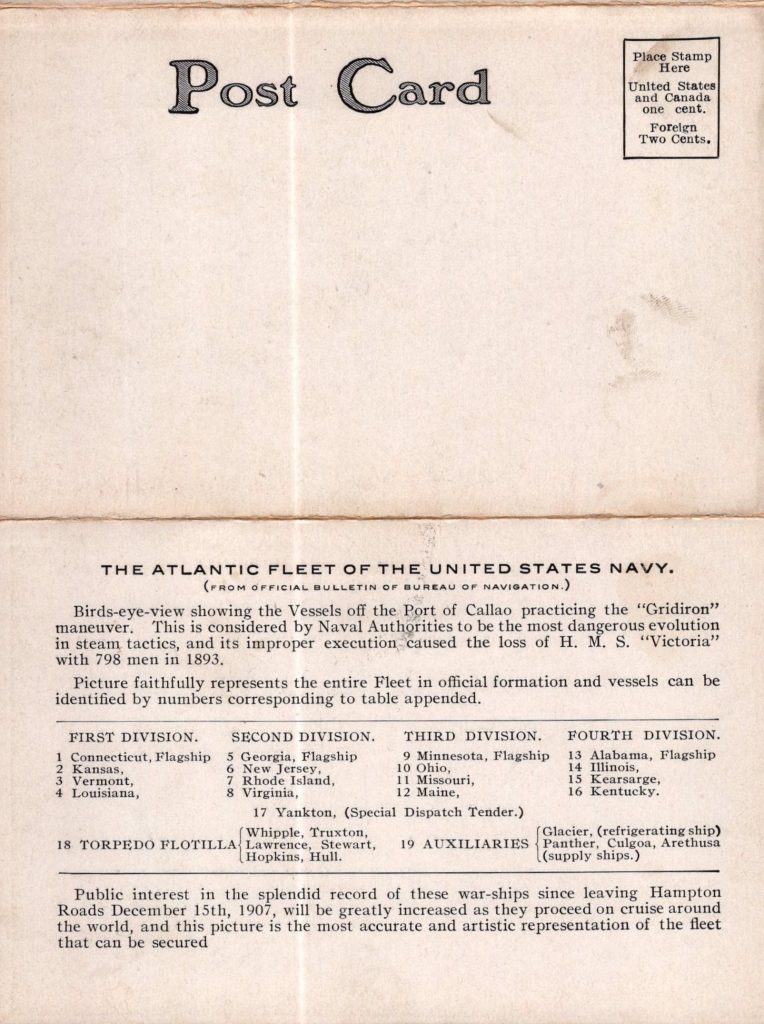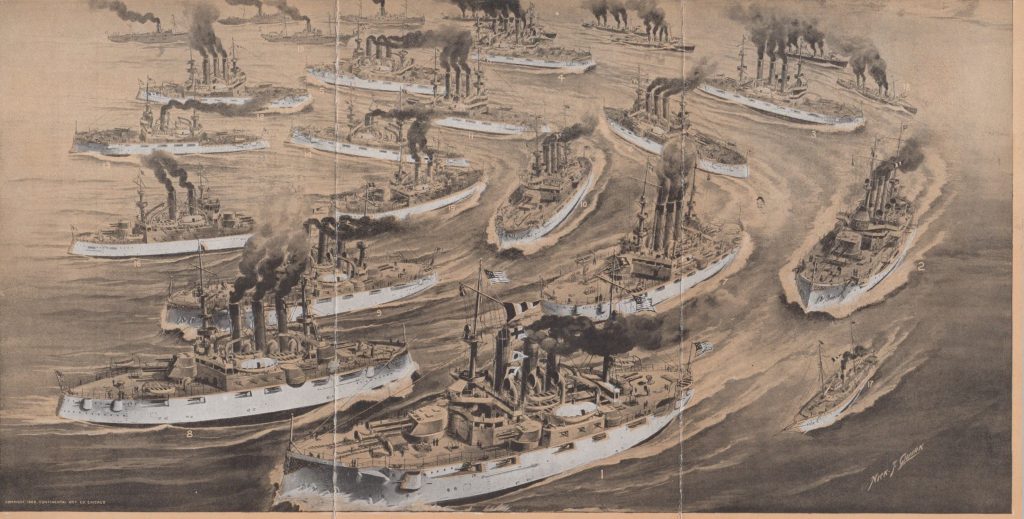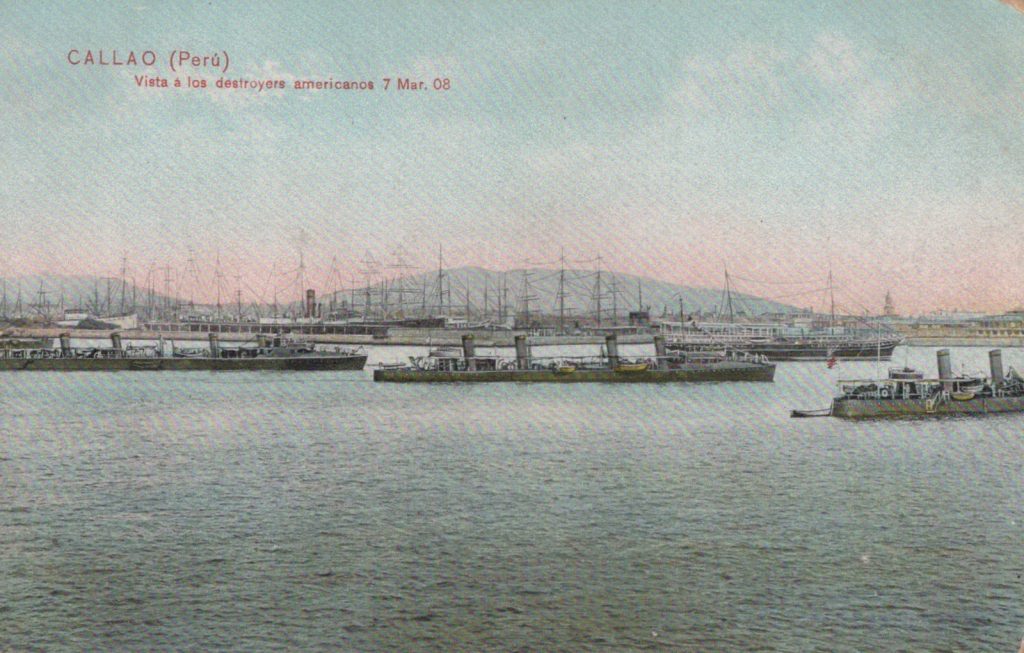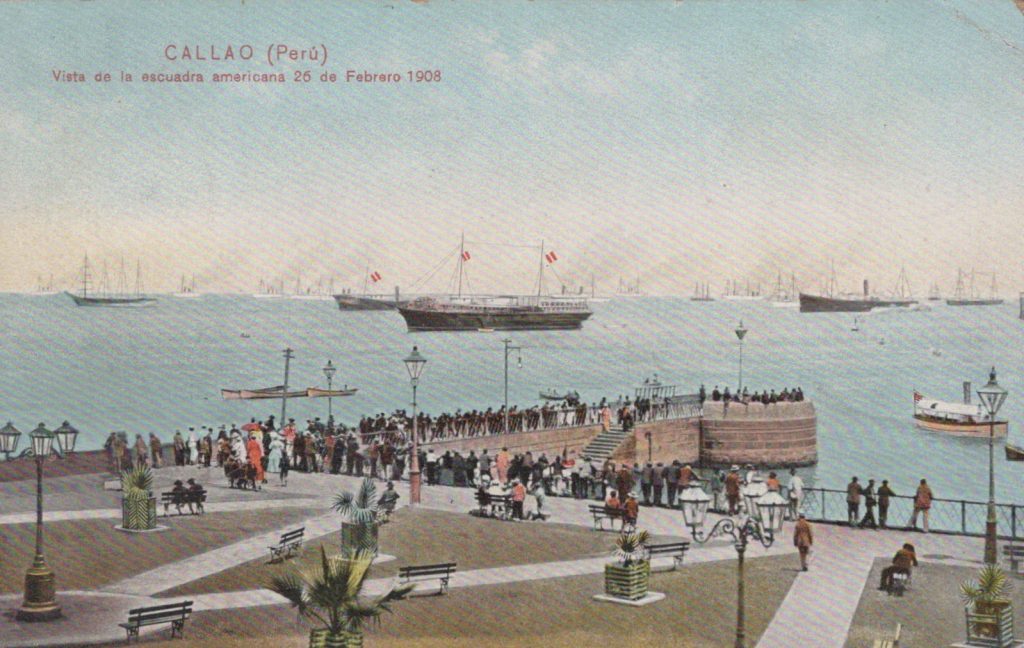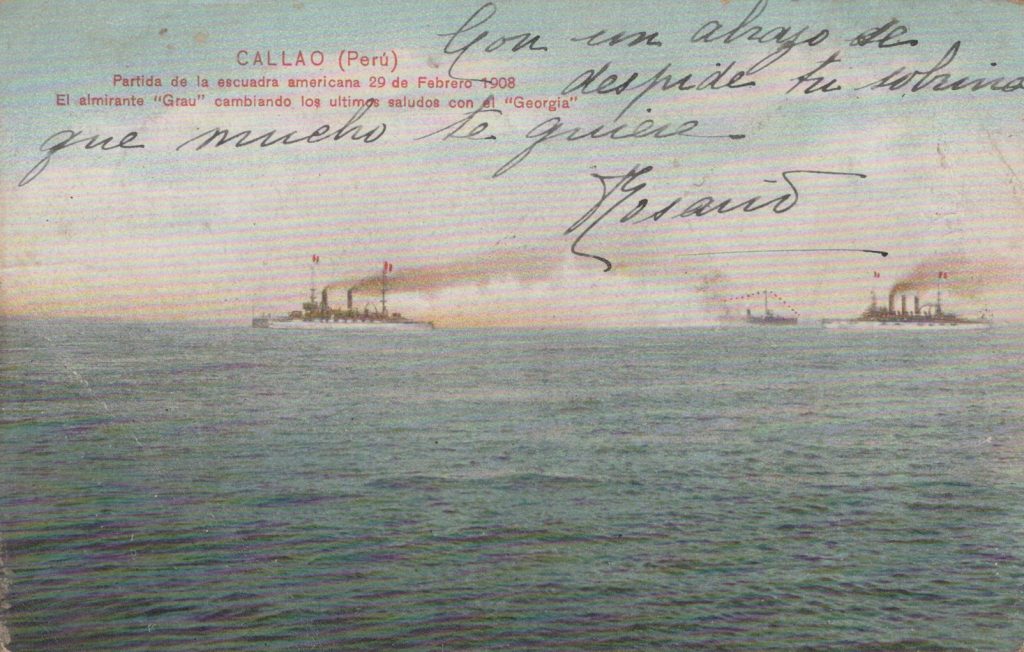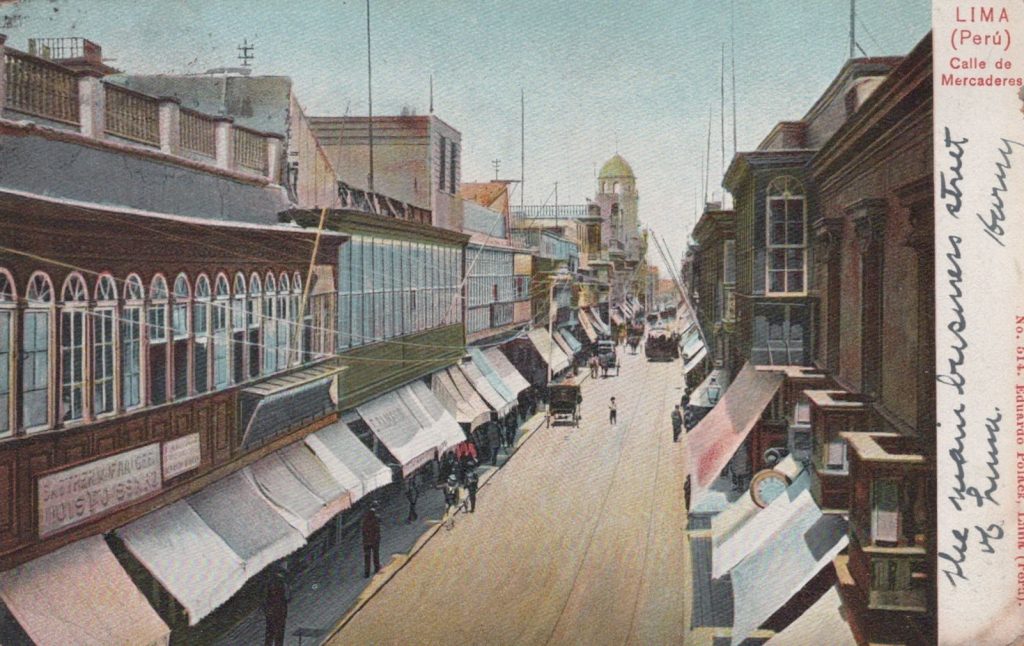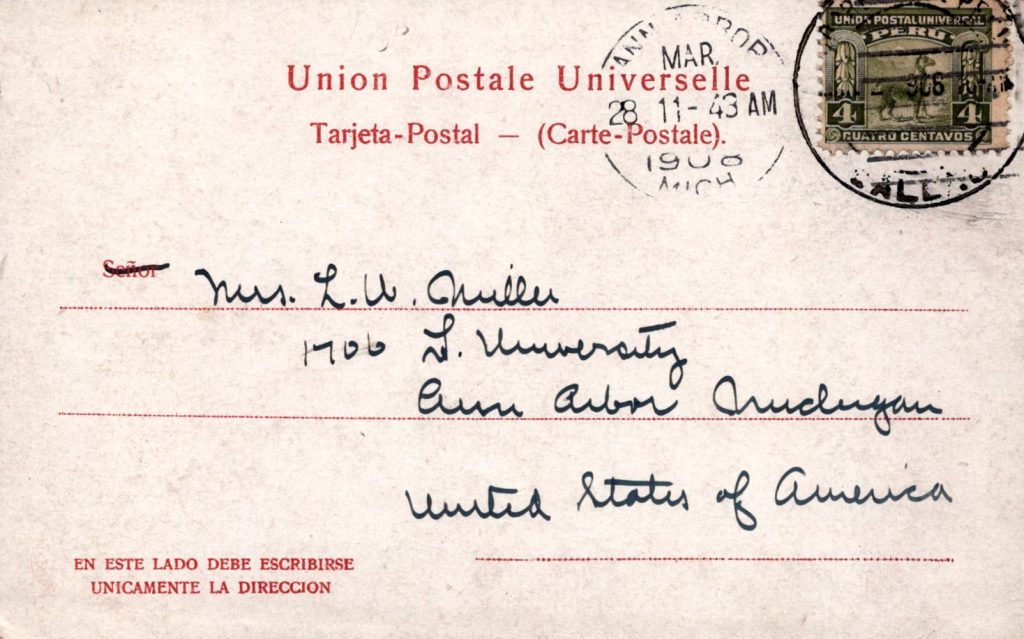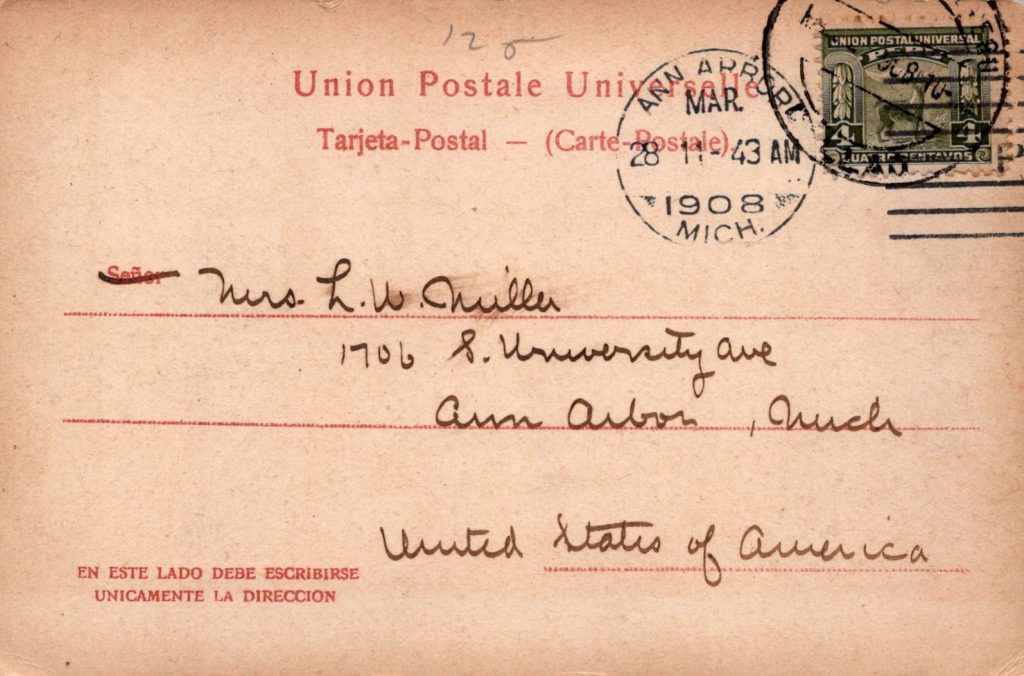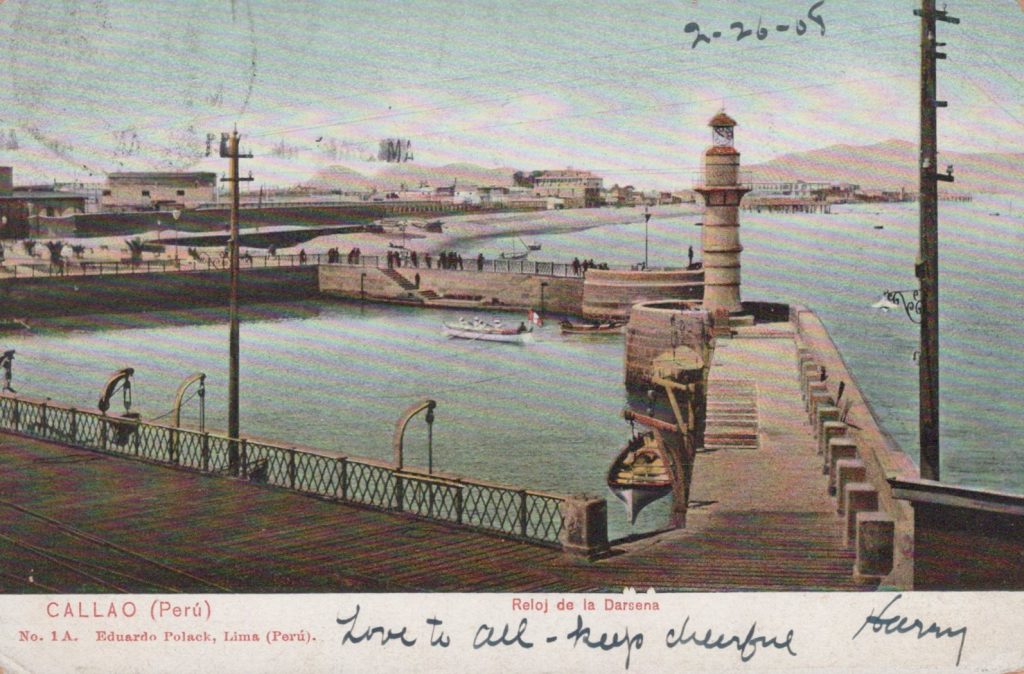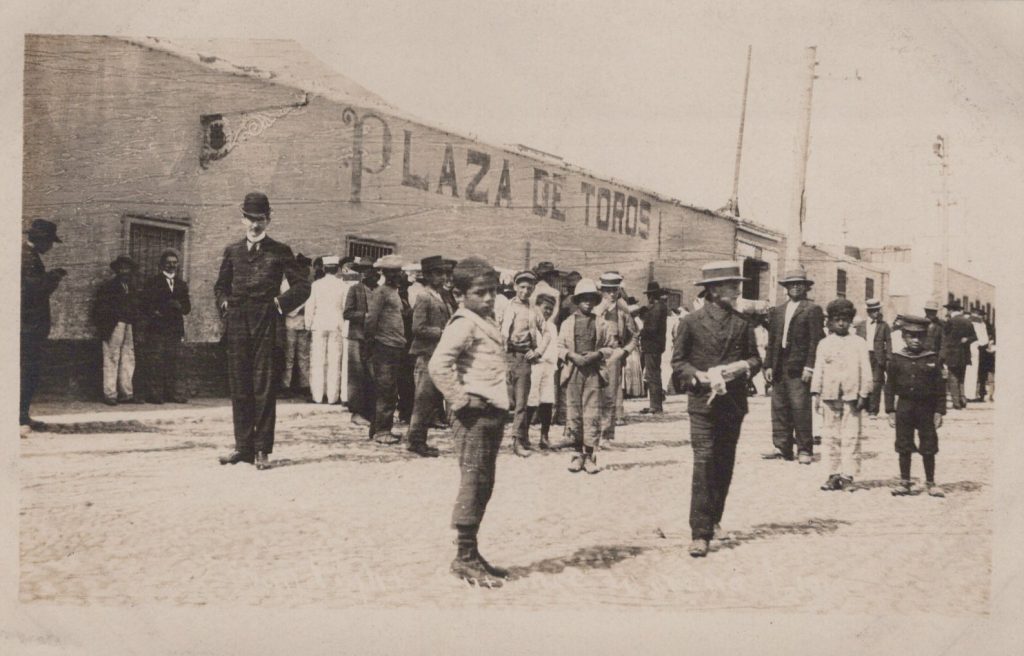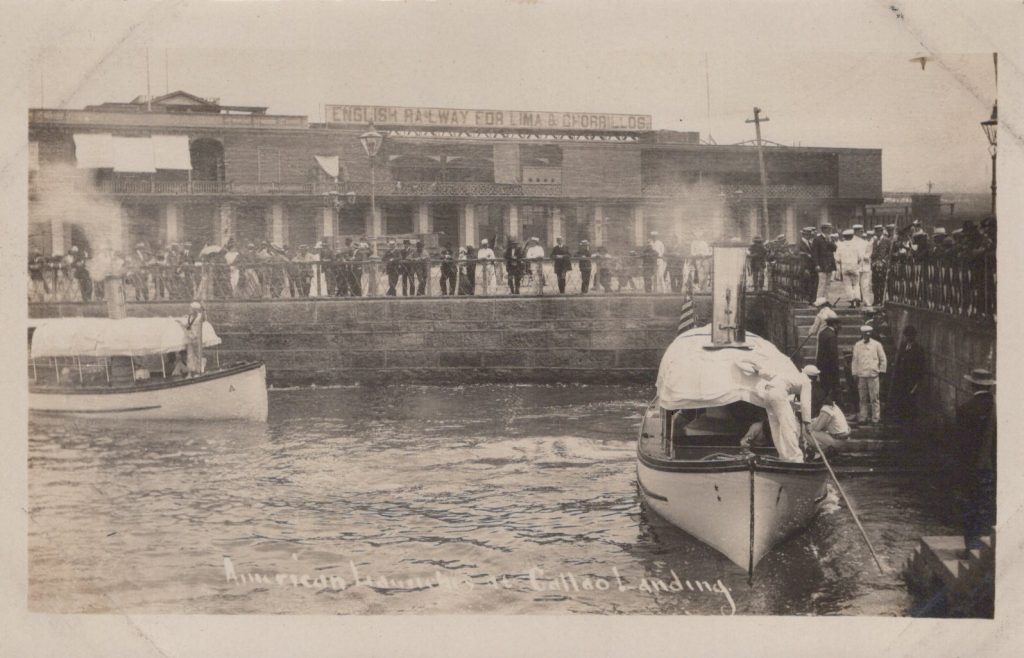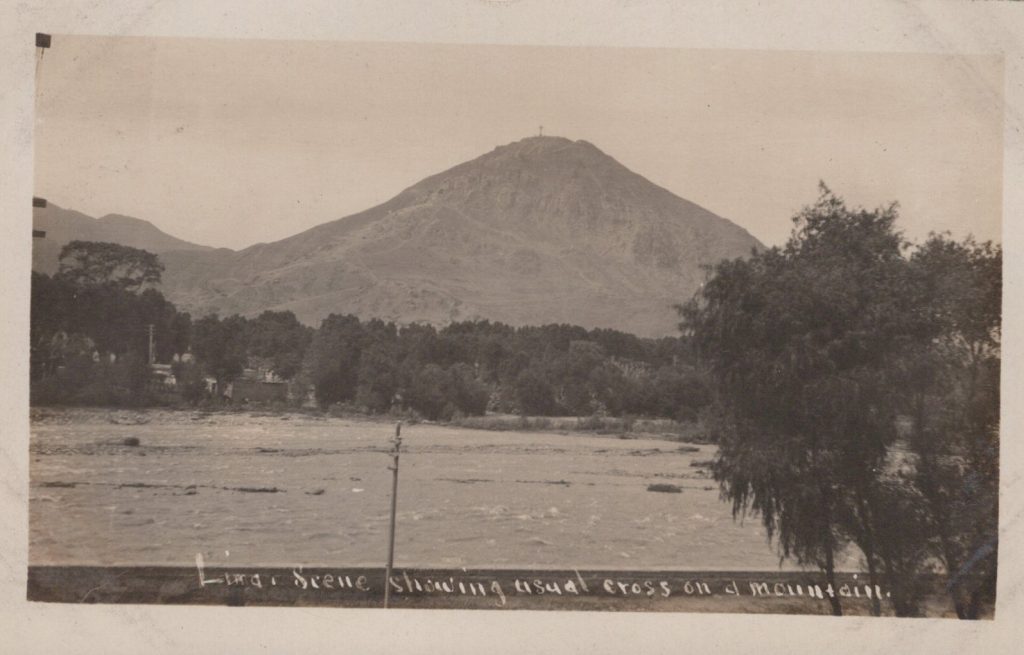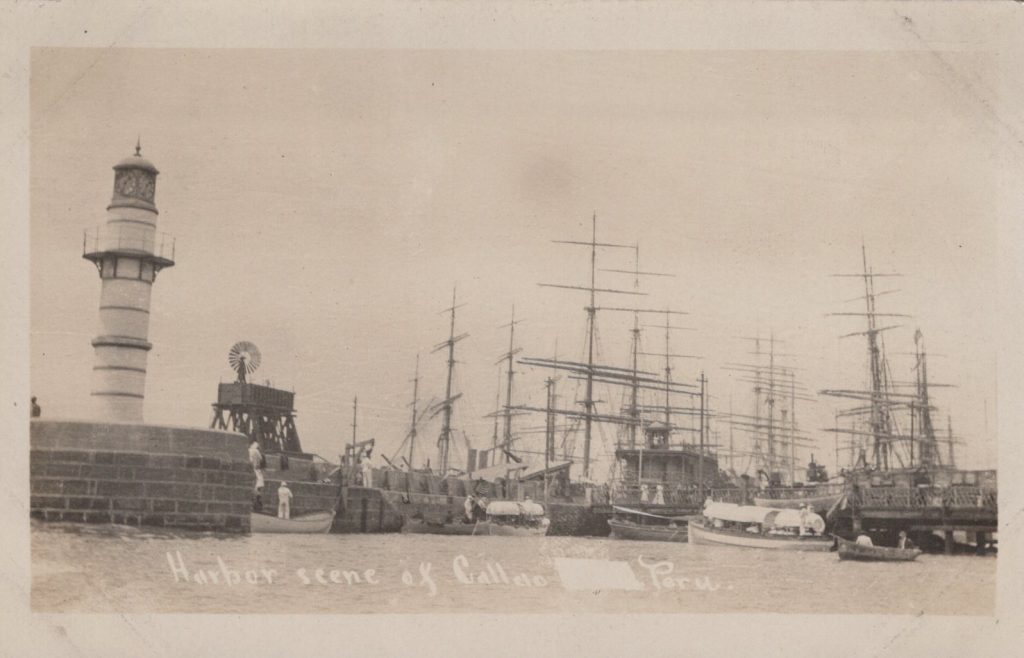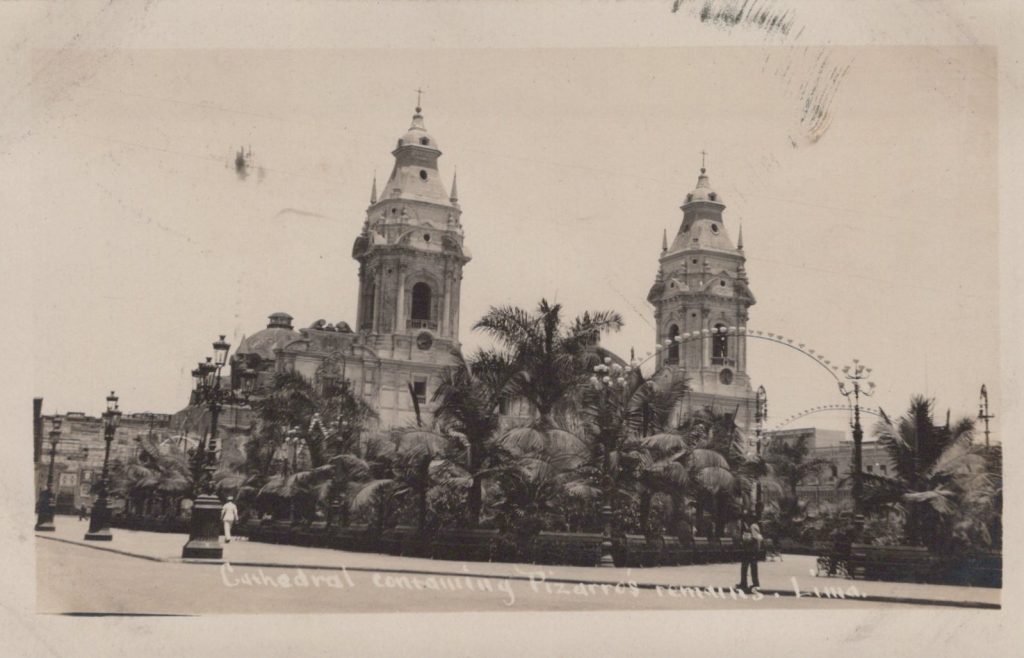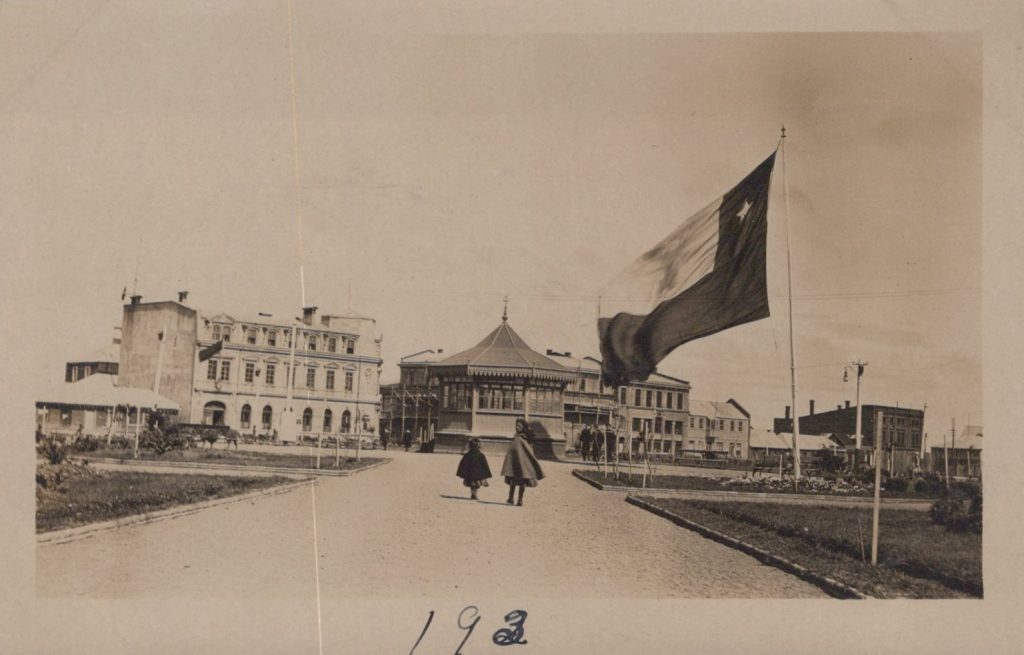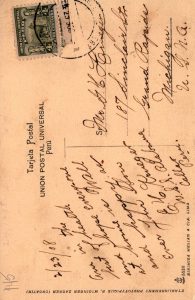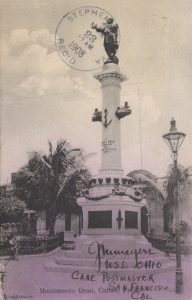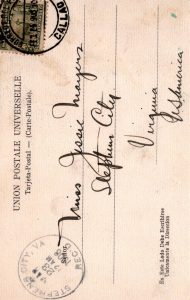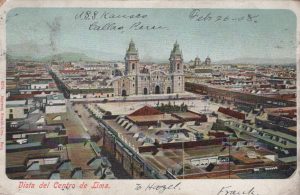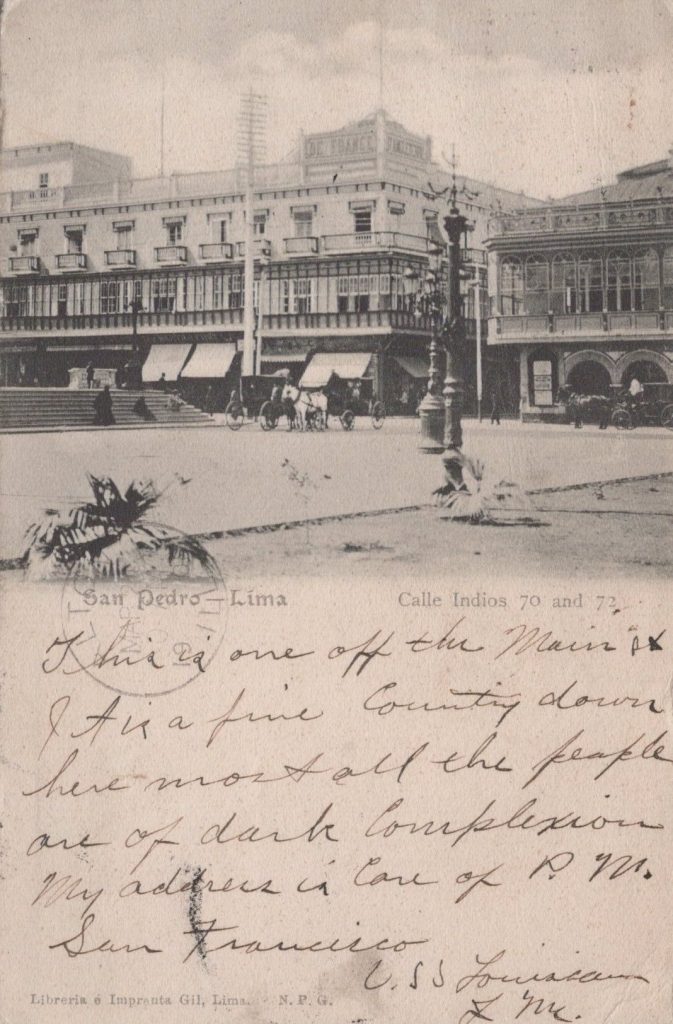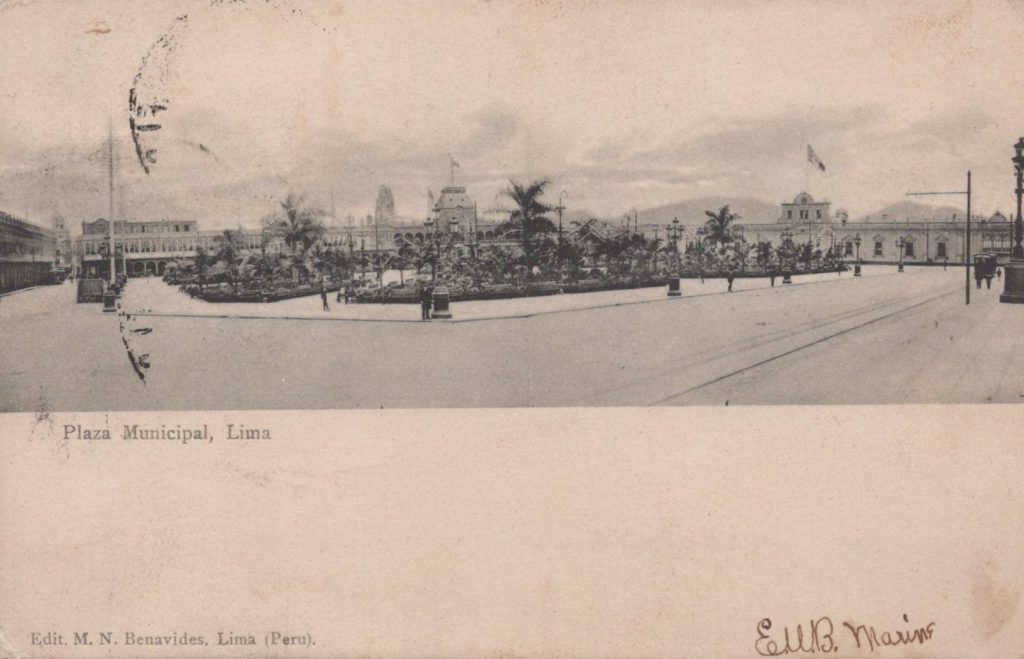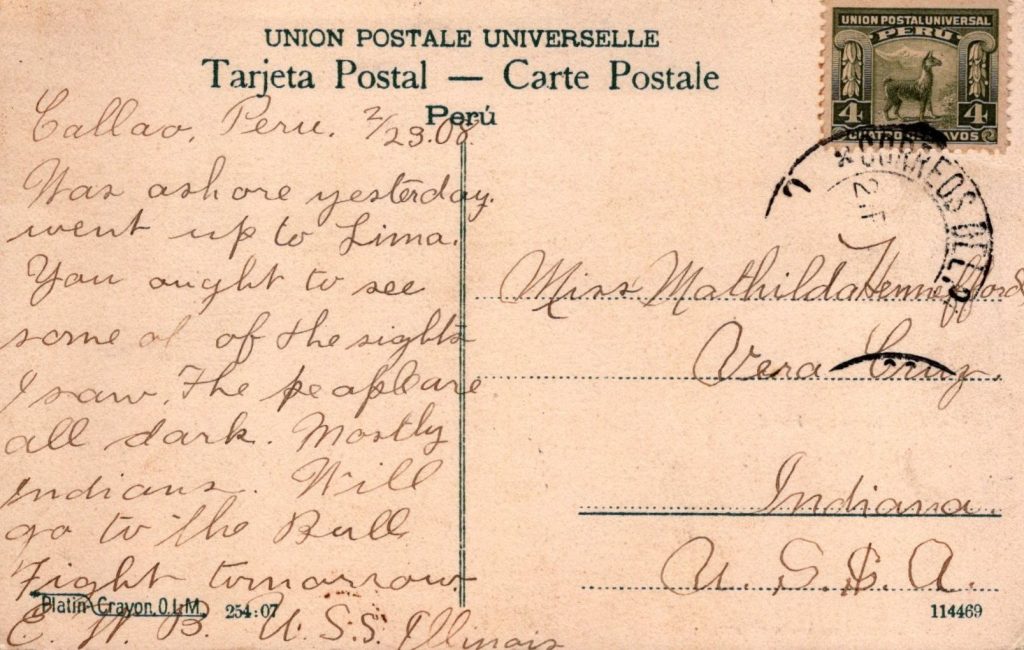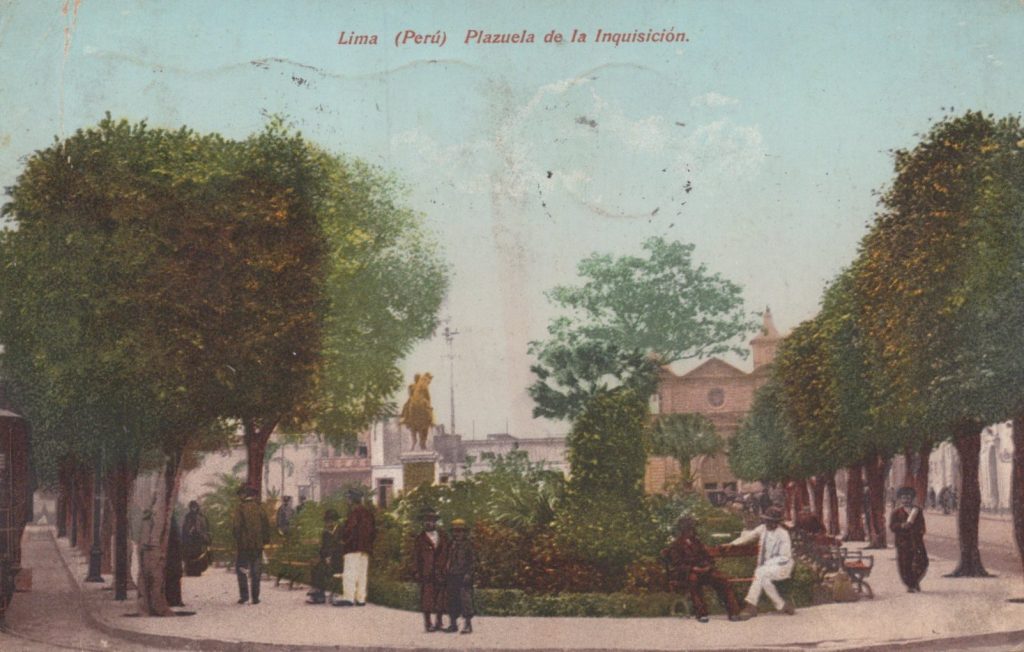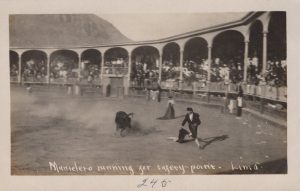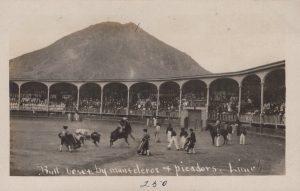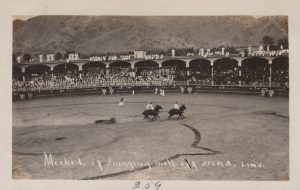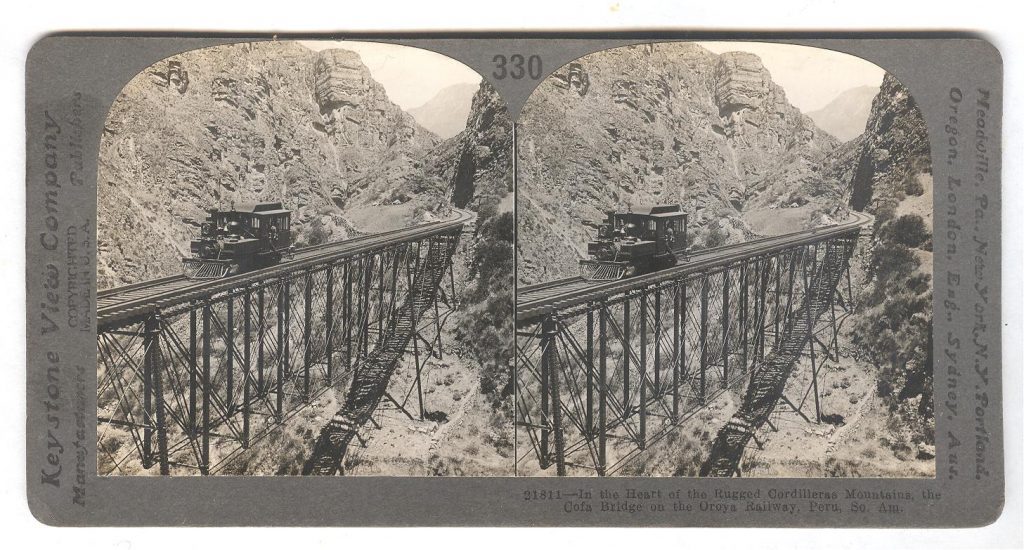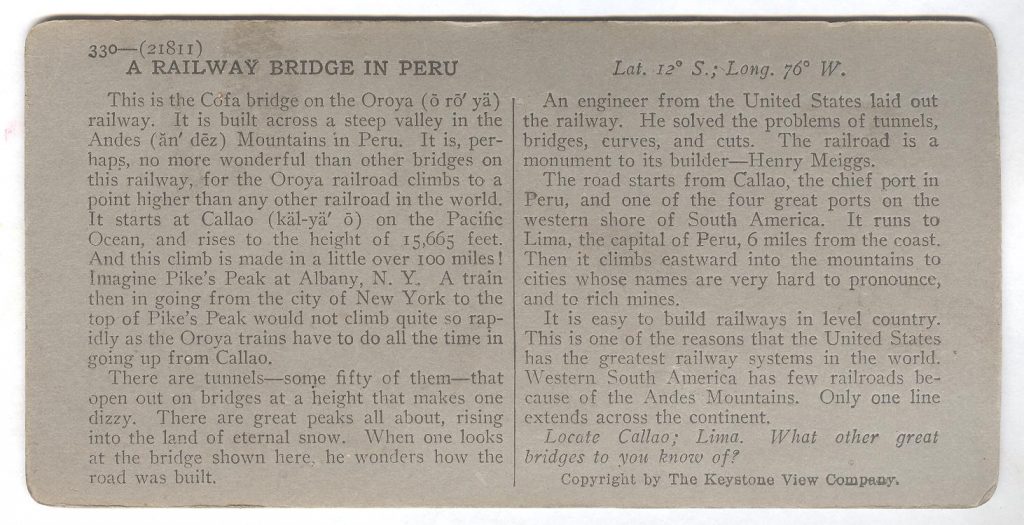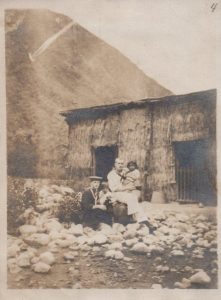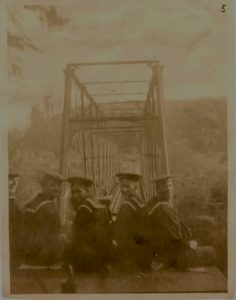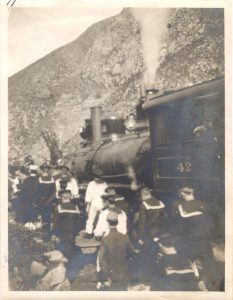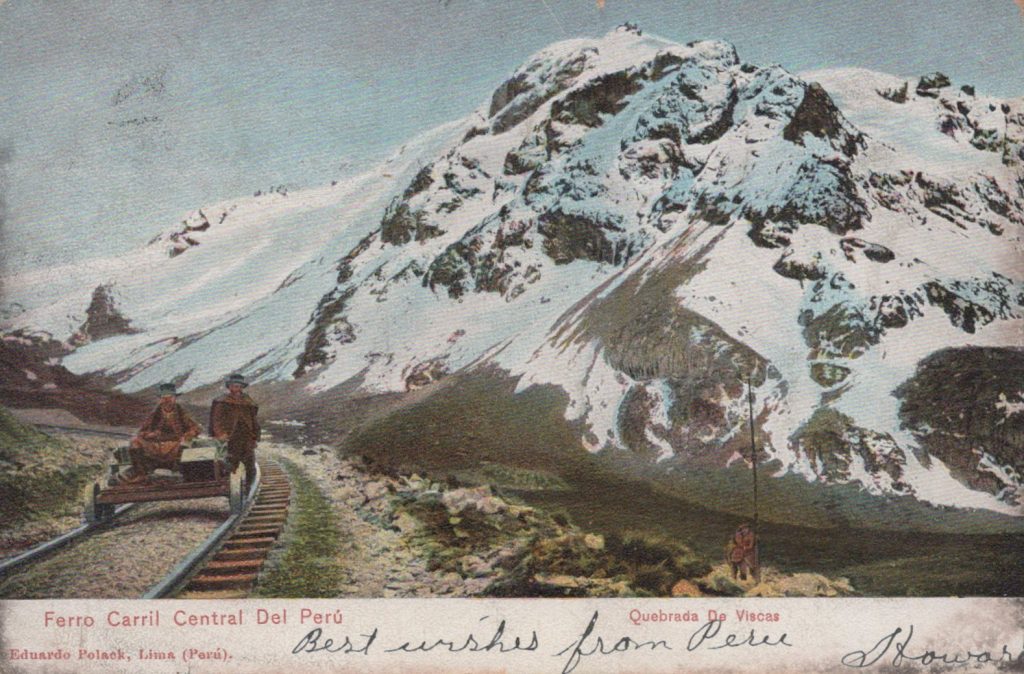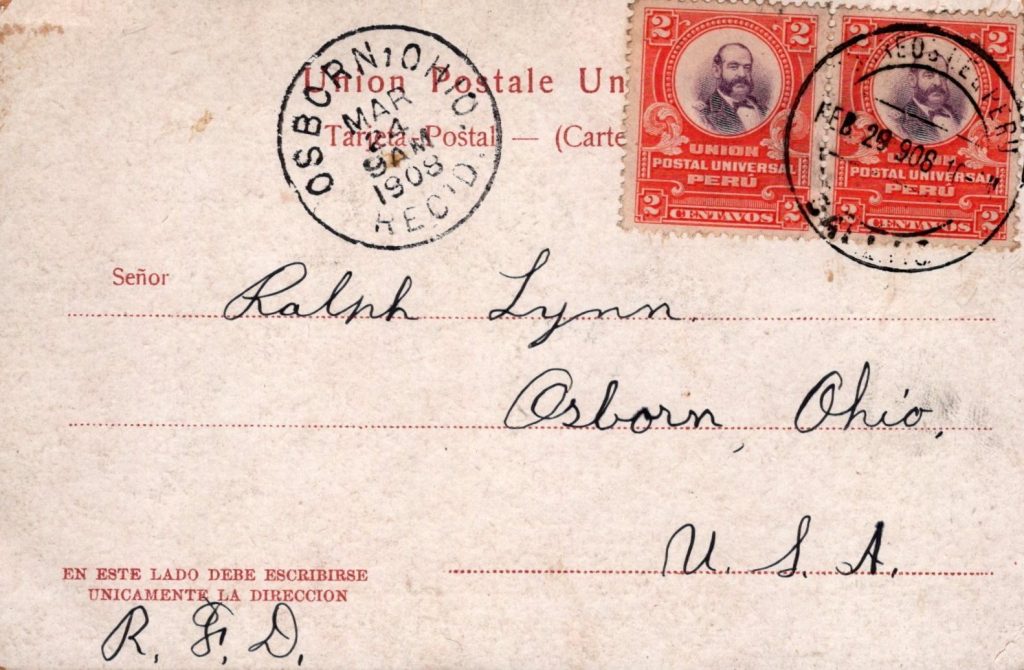Apologies, but no results were found for the requested archive. Perhaps searching will help find a related post.
At Callao, the Peruvian government did its best to welcome the fleet. Having been at conflict with Chile and Brazil, Peru was looking for an ally in America and delivered a warm greeting for the ships. They were met 250 miles from Callao by the Cruiser Bolognesi which escorted the ship into a crowded harbor to a warm reception. By this time in the cruise, the crews had grown tired to the receptions and clearly were not as crisp in going to anchorage as a previous ports. Admiral Evans issued a reprimand to the fleet for its un-seaman like approach.
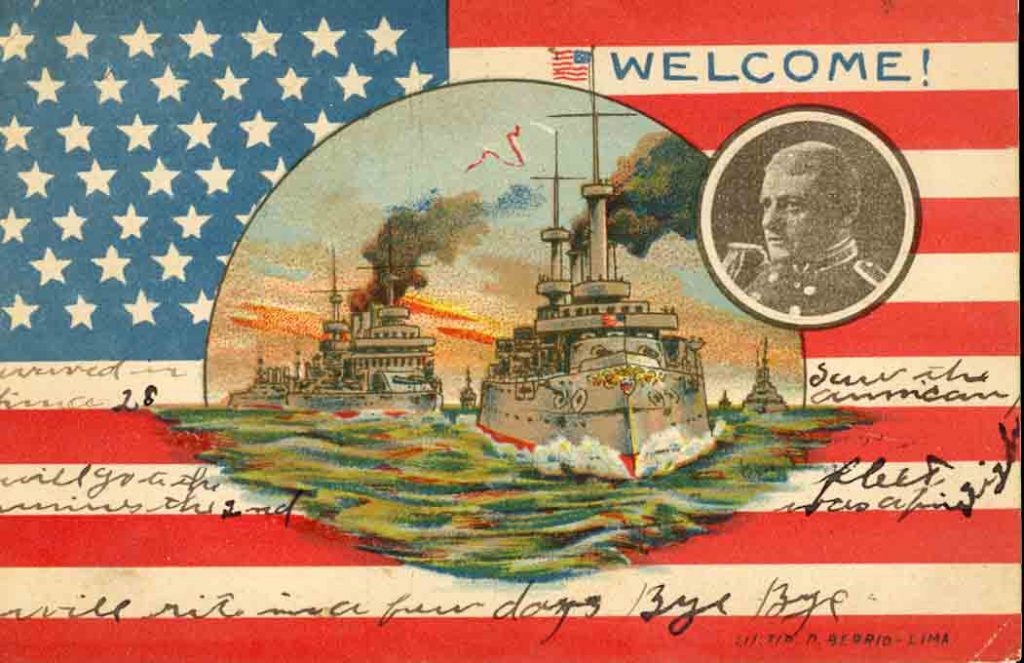
"Arrived in Lima 28, will go to the views the 2nd. Scare the American fleet was afraid to fight. Will write in a few days, Bye Bye.
"gridiron'
Before arriving in Callao, the fleet practices maneuvers including the "Gridiron" which was considered one of the most dangerous maneuvers for a fleet of warships to complete at the time. The maneuver involved a formation of ships to execute a turn, simultaneously, to arrive at a new course. With ships aside, in front, and behind, this maneuver requires each ship to adjust rudder orders without a given course throughout the turn.
This card was originally produced as a magazine fold out and reproduced as a postcard after the fleet's departure from Peru.
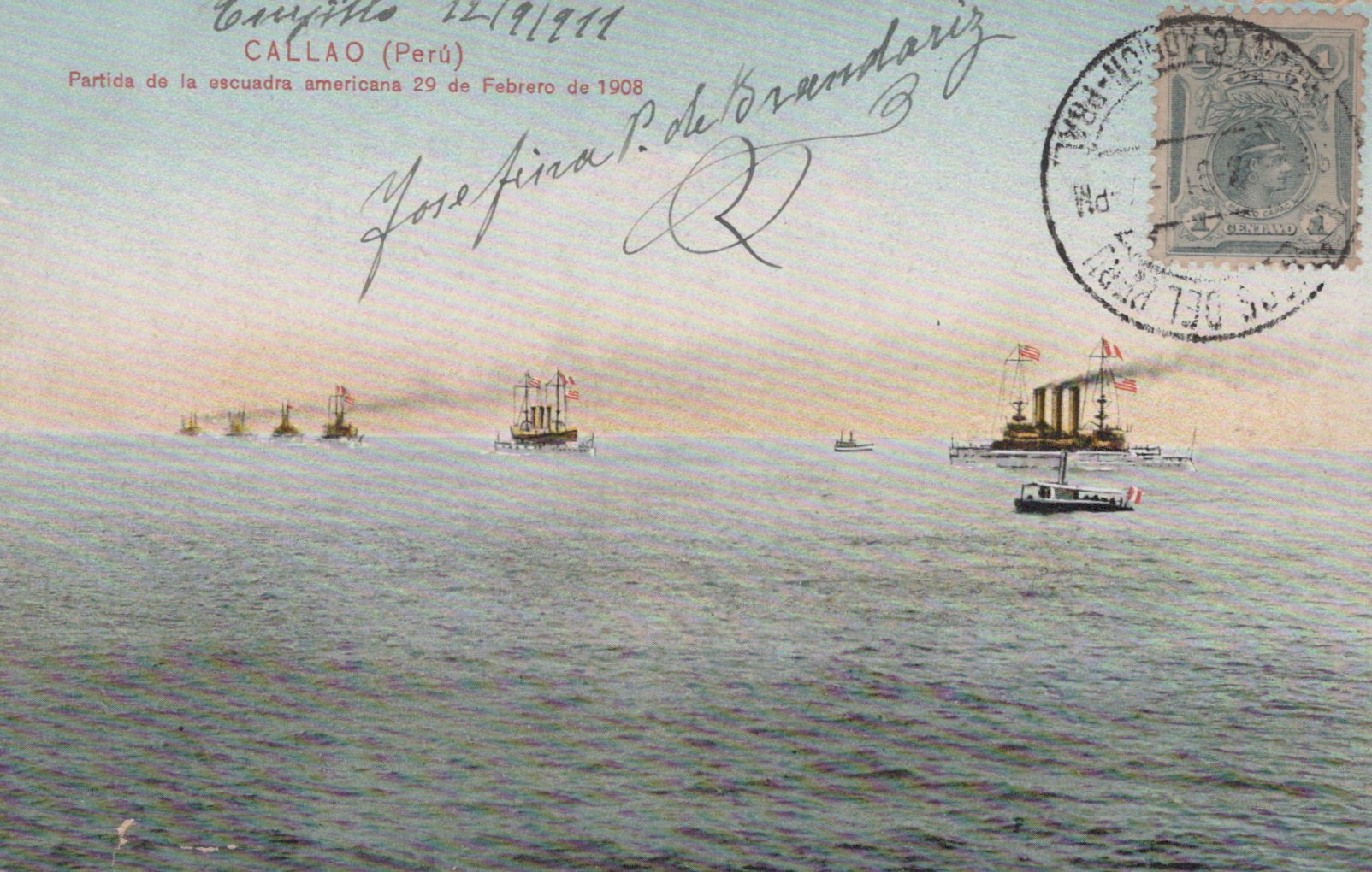
This is a set of cards that was issued after the fleet's departure showing the fleet entering the harbor, at anchor, and crew launches coming in to the quay wall of the inner harbor to go ashore.
As part of my "bucket list" I have visited Callao, as yes, the inner harbor shown in the images is still there!
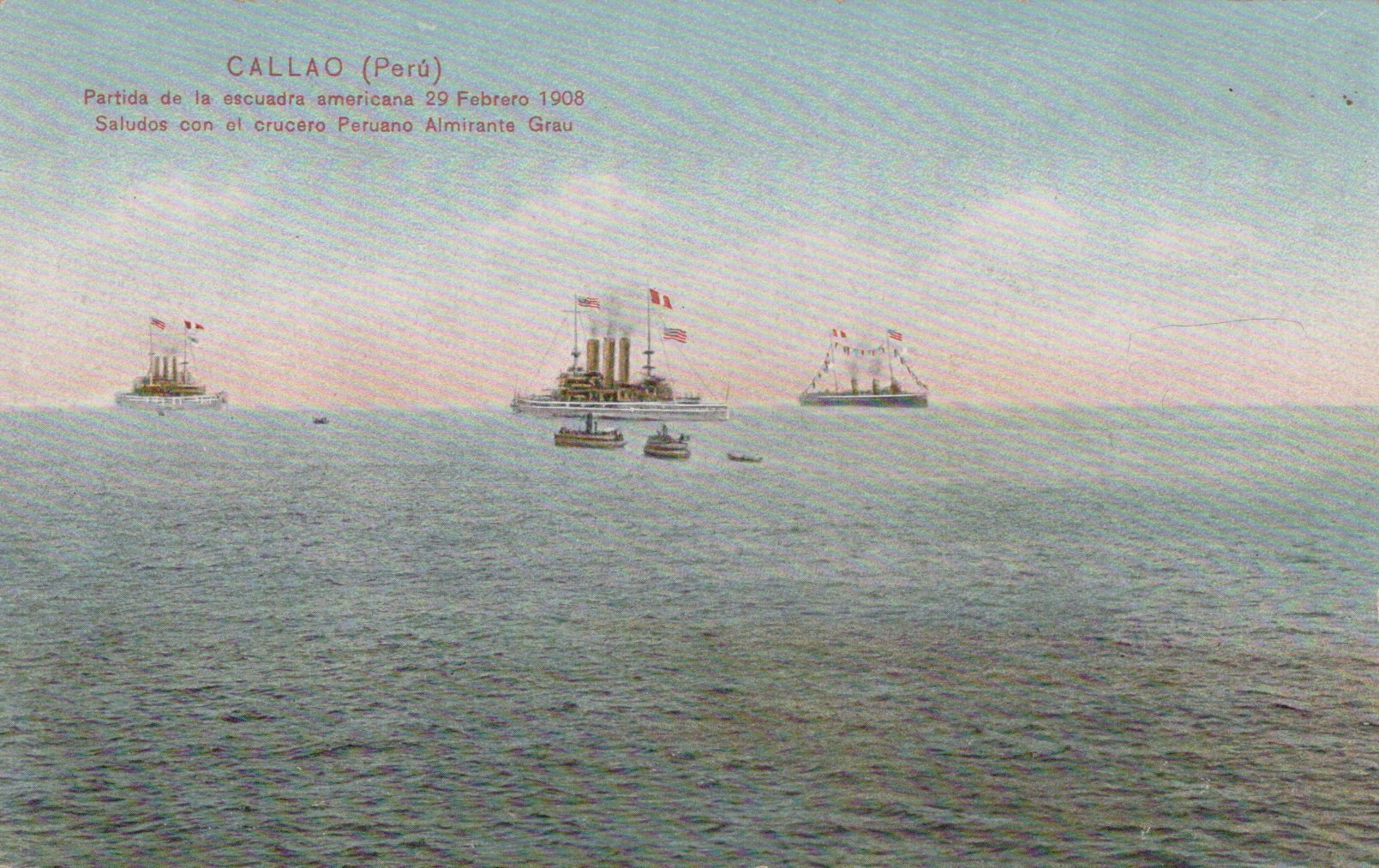
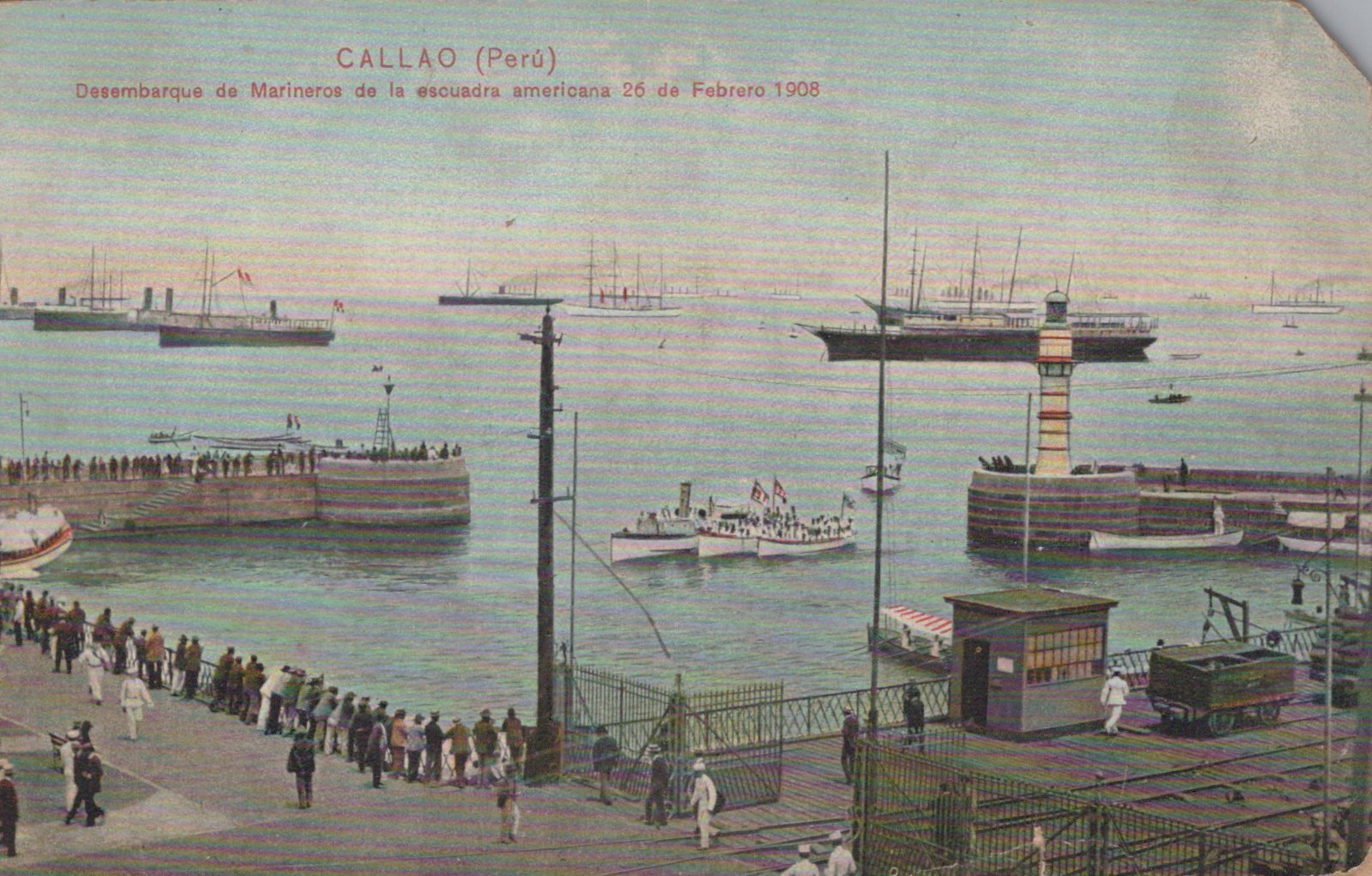
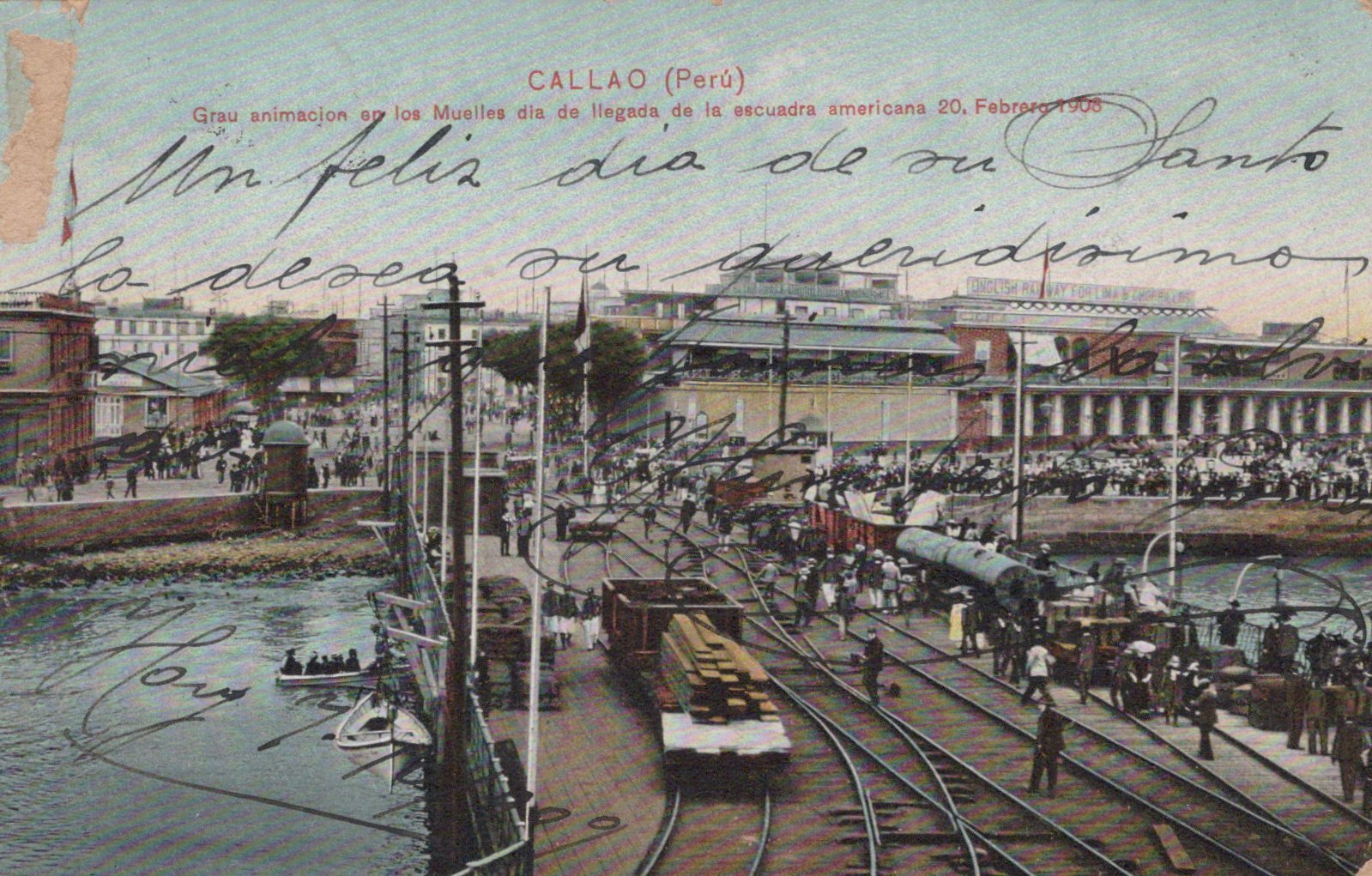
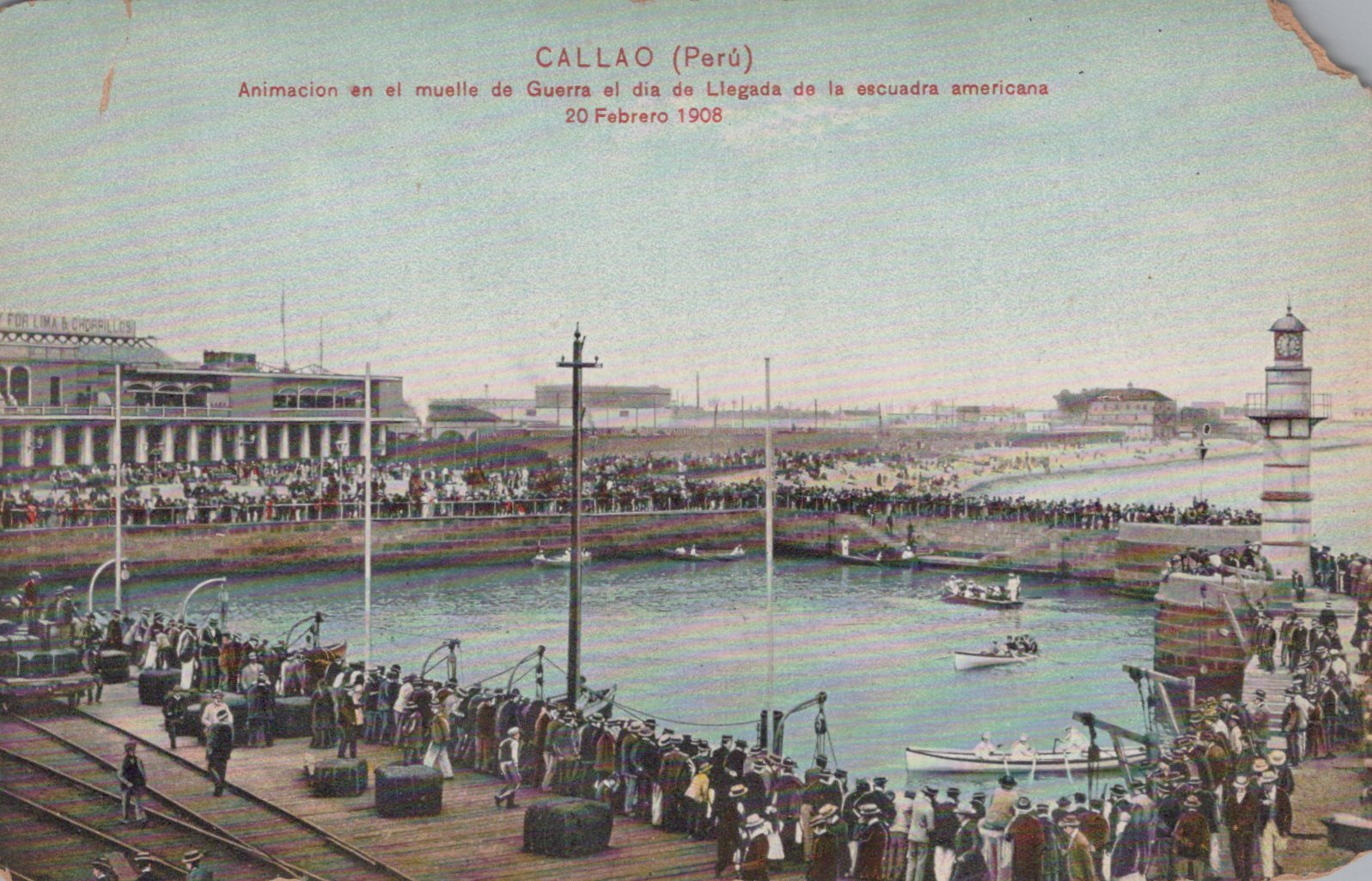
sites of lima
These two card were sent from Harry Miller, Petty Officer 3rd Class, USS Rhode Island to his wife back in Ann Arbor, Michigan. The two cards were posted while the ship was in port and franked with local postage. "The Main Business Street of Lima" showing downtown business district of Lima.
The second card showing the harbor quay wall where small boats could disembark passengers. This is where the fleet steamers brought liberty boats from the ships for sailors to disembark during their say in Callao. "Love to all - keep cheerful"
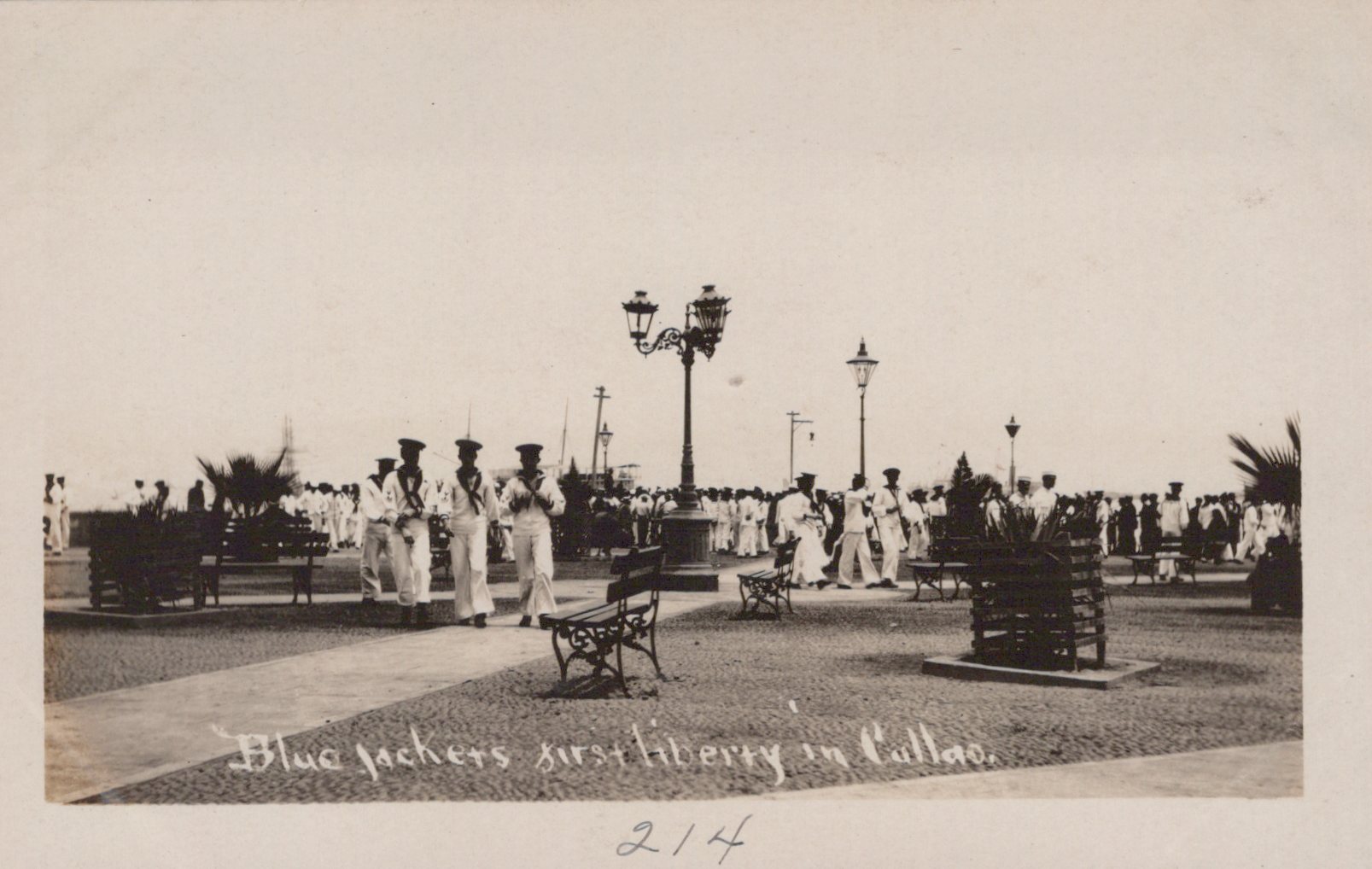
Brown and Shaffer took many photographs for postcards while in Callao. These were typically numbered in the "200s" like these two, 214 - Blue jackets first liberty in Callao, and 224 - Fruit venders of Callao. The handwriting of the B & S cards is always distinctive. My collection from Callao is primarily of the bullfight. I don't believe cards were printed until they were ordered, by number, and so many of the cards that they produced might be quite scarce as they were not popular to purchase, like "Fruit venders of Callao." The complete collection of Brown and Shaffer cards can be accessed through this link on my site.

President Pardo had planned for the arrival of the American fleet. He had sent spies to earlier ports to gather information regarding how the fleet had been received. It was quickly translated into businesses and a community prepared to greet sailors. Signs "American Spoken Here," organized dances for the sailors, and efforts to prevent conflict within the community while sailors were ashore. They went so far as to lock up a traveling group of Japanese acrobats that were visiting the city as fear they may be spies or offend the American sailors.
2/23/08 Am in the best of health and hope everyone at home is well and happy as ever. Your Son E. Y. Krueger, USS Alabama, Callao Peru" A nicely posted card from Callao from Second Class Machinist Krueger.
In downtown Lima is a Monument dedicated to the Pacific War (1879-1884) hero Admiral Miguel Grau who lost his life in battle of Angamos. He is known as el Caballero de los Mares ("Gentleman of the Sea) and is esteemed by both Peruvians and Cileans. He is remembered for acts of kindness during war. At the port of Antofagasta he allow crewmembers of the Matias Cousino to abandon ship before his plans to finish the damaged ship by sinking.
This card was mailed by G. M. Mayers, Seaman, USS Ohio to his sister Jessie from Callao and cancelled on February 25, 1908.
These are cards from downtown Lima, the first two of the Municipal Plaza and the third of the Chapel of San Marcelo. The Cathedral of Lima at the Municipal Plaza remains one of the most important attractions of Lima with the Presidential Palace located just to the right in the same plaza. While I was visiting the President went to mass on Sunday at the Cathedral and returned to the palace afterwards with marching band and troops. The center card was mailed by Frank onboard the USS Kansas,to Hazel of Vandergrift, February 26, 1908 and received in North Grove, Pennsylvania on March 23rd.
san pedro, lima
The area around the Basilica and Convent of San Pedro, Saint Peter Church, is the historic center of Lima. Completed in 1638, it is now a UNESCO World Heritage site. The two buildings shown are part of the Indian Market (Calle Indios) The market still survives today and is a popular stopping place for tourists.
The card at left is written from a sailor onboard the USS Louisiana to Miss Irene Conley of Alton, Illinois. "this is one of the main street. It is a fine country down here. Most all the people are of dark complexion. My address is care of P.M. San Francisco. USS Louisiana L.Mc"
The first card above shows the municipal plaza in downtown Lima. It is the birthplace and hub of the city. It includes the Government Palace, Cathedral of Lima, the Municipal Palace, and the Palace of the Union. The Card was sent by E.W.B on the USS Illinois, "Callao, Peru 2/23/08, Was ashore yesterday went up to Lima. You ought to see some of the sights I saw. The people are all dark. Mostly Indians. Will go to the Bull Fight tomorrow." The second card is of the Plaza of the Inquisition, one of the three main plazas in Lima. It is the site of the former Tribunal of the Inquisition. The card was sent to Miss C. D. Anthony on February 21, 1908 with American postage, "This is one of the numerous pretty parks around here. There's room for two at least on some of the seats. Yours with Love, W"
This was one of the main events planned for the sailors, a Bullfight at the Plaza do Toros! Three-thousand officers and men were transported by special train to the event and offered the best seating for what was planned as premier bull fighting. The government had planned to prevent any horses from getting gored by a bull, understanding that the Americans would find it cruel. Unfortunately, in the first fight one of the horses took a horn from the bull. It was followed by the bull catching the matador with its horns and tossing him out of the ring. In the next two fights the matadors hacked at the bull repeatedly but failed to kill the bull in a humane manner. At this pint the American guests became uncomfortable with the treatment of the bull and began hissing and booing. The last of the fights included one matador getting gored to the audience fear of his death. By the end, many sailors had left the stadium deciding the event was unfair to the bulls and would rather not watch. Below is the program of the event that was handed out to sailors. This one folded in half and probably carried around in a pocket for the day.
The second big event planned for the sailors was a train trip to the top of Mount Oroya, the highest railroad in the world. This recently completed line went through the mountains at a height of 13,000 feet. Two trains were planned for the journey, the first for the "official" party and the second for sailors and other guests. At a height of 10,000 feet, the second train stalled. Some were already suffering from altitude sickness from the quick assent, but now many more began to suffer. Then came word from the first train at 13,000 feet that there had been an avalanche blocking the line. At this point many were stricken with vomiting and laid out on the floor. One passenger actually died from their condition. At this point the first train could not remain at 13,000 feet and made a slow decent to where the clockage in the tracks had occurred. Here there were accommodations of four beds for the overnight stay which had been commandeered by members aboard the second train leaving the members of the official party to sleep onboard the train that evening. The next day, sick and exhausted they were able to climb around the obstruction and board a train to return to Callao. Surely this had been a memorable event from the cruise for many of the sailors. My collection include rare photographs from Richard Konter who was on the second train and went to view the avalanche. Below a photos: 1. Stopping the train to visit locals. 2. Riding on top of the train, 3. Viewing the avalanche. 4. Walking on tracks near locomotive. 5. Posing near avalanche.
ferro carril central del peru
The central Trans-Andean Railway linking the port of Callao and Lima to the rest of the country. The line starts in Callao and crosses into Junin state via the Galera Tunnel, the second highest railroad tunnel in the world. It reaches La Oroy where it splits into two branches. The card was sent by Howard Lynn, USS Rhode Island and cancelled in Callao on February 29, 1908 with local postage.
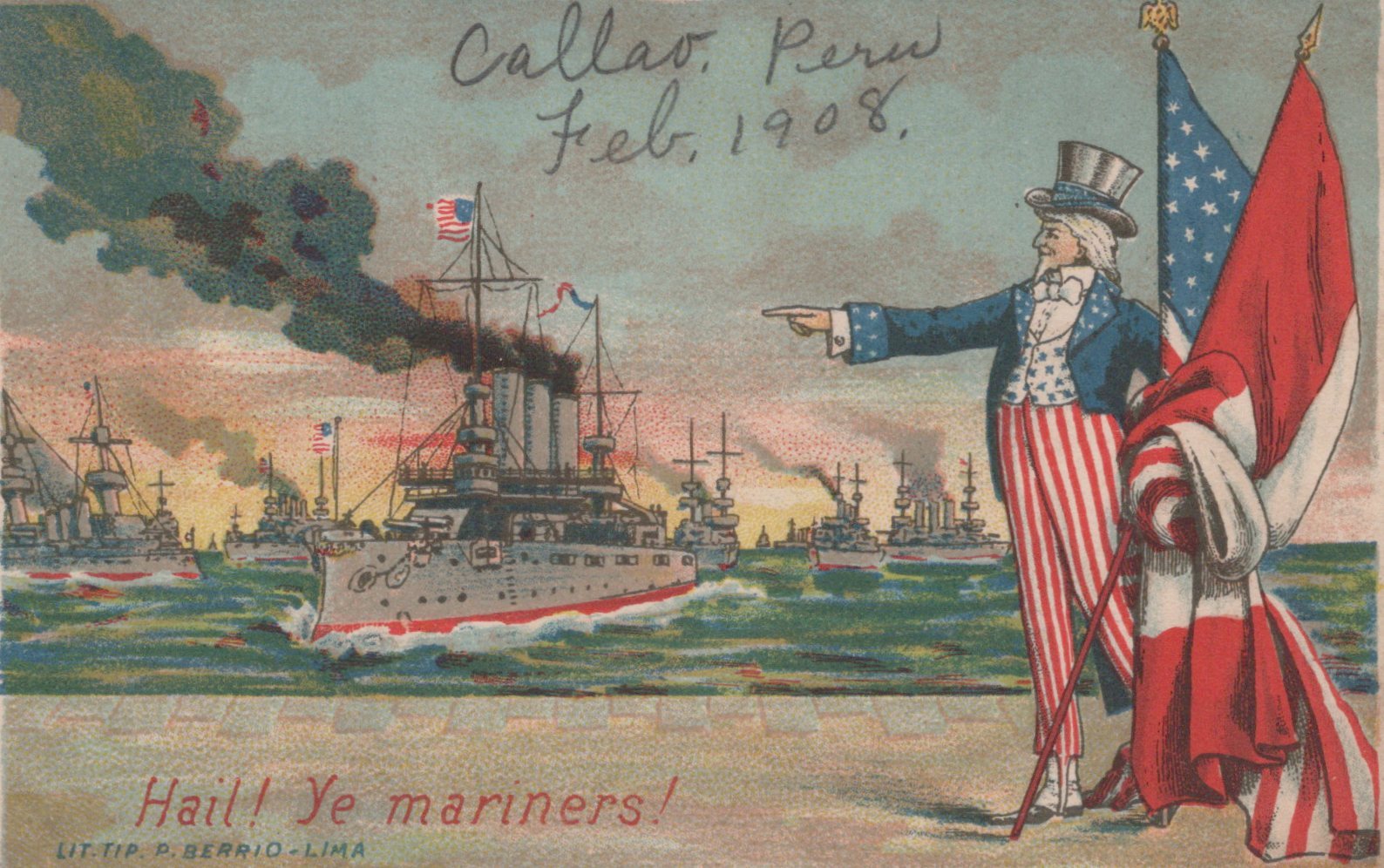
On February 29th the fleet departed the harbor providing a 21-gun salute to President Pardo on his yacht at the mouth of the harbor. Everything went well with the exception of the sailor onboard the Ohio who tried to "jump ship" by having a small boat standing by to receive him as the ships steamed out of the harbor. Unfortunately, the Georgia saw the act of the deserter and quickly lowered boats to apprehend the man before he could get ashore. The ships were on the way to proceed with a much needed period of target practice in Magdalena Bay, Mexico.
At left, a card that was produced and available while the sailors were in Callao! Uncle Sam, Hail! Ye Mariners! was mailed to Mrs. Charles Ward in Gross, Ohio and cancelled in San Diego, March 15, 1908.

